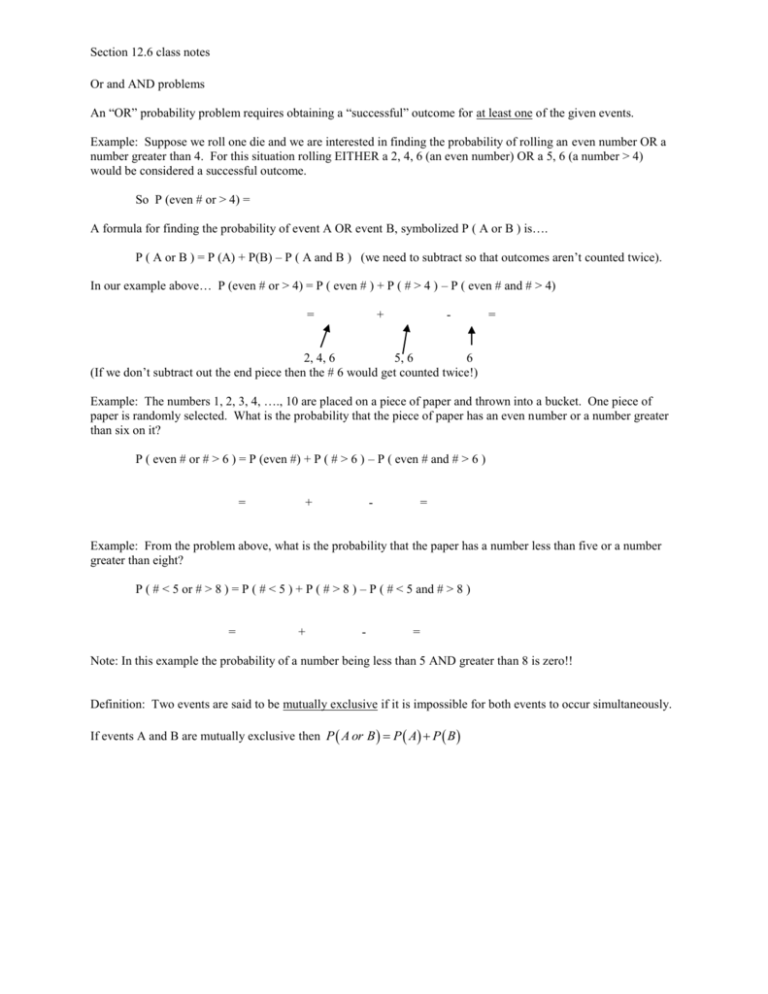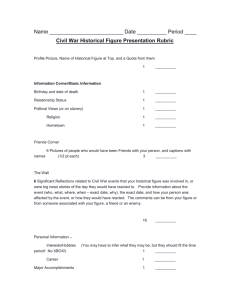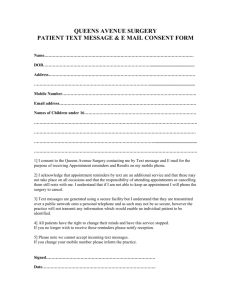section 12.6 and 12.7 class notes
advertisement

Section 12.6 class notes Or and AND problems An “OR” probability problem requires obtaining a “successful” outcome for at least one of the given events. Example: Suppose we roll one die and we are interested in finding the probability of rolling an even number OR a number greater than 4. For this situation rolling EITHER a 2, 4, 6 (an even number) OR a 5, 6 (a number > 4) would be considered a successful outcome. So P (even # or > 4) = A formula for finding the probability of event A OR event B, symbolized P ( A or B ) is…. P ( A or B ) = P (A) + P(B) – P ( A and B ) (we need to subtract so that outcomes aren’t counted twice). In our example above… P (even # or > 4) = P ( even # ) + P ( # > 4 ) – P ( even # and # > 4) = + - = 2, 4, 6 5, 6 6 (If we don’t subtract out the end piece then the # 6 would get counted twice!) Example: The numbers 1, 2, 3, 4, …., 10 are placed on a piece of paper and thrown into a bucket. One piece of paper is randomly selected. What is the probability that the piece of paper has an even number or a number greater than six on it? P ( even # or # > 6 ) = P (even #) + P ( # > 6 ) – P ( even # and # > 6 ) = + - = Example: From the problem above, what is the probability that the paper has a number less than five or a number greater than eight? P ( # < 5 or # > 8 ) = P ( # < 5 ) + P ( # > 8 ) – P ( # < 5 and # > 8 ) = + - = Note: In this example the probability of a number being less than 5 AND greater than 8 is zero!! Definition: Two events are said to be mutually exclusive if it is impossible for both events to occur simultaneously. If events A and B are mutually exclusive then P A or B P A P B Example: One card is selected at random from a standard deck of playing cards. Determine the probability of P ( A or B ) in each case below… 1. A = an ace B = a jack solution: since A and B are mutually exclusive.. 2. A = an ace P ace or jack P ace P jack B = a diamond solution: A and B are NOT mutually exclusive!!!!.. P ace or diamond P ace P diamond P ace and diamond 3. A = a red card B = a black card solution: since A and B are mutually exclusive.. P red or black P red P black 4. A = a picture card (J,Q,K) B = a red card solution: A and B are NOT mutually exclusive!!!!.. P picture card or red P picture card P red P picture card and red The AND problems discussed below involve repeating an experiment twice. An “AND” probability problem requires obtaining a favorable outcome in each of the given events. P A and B P( A) P(B) Example: Two cards are selected with replacement from a standard deck of cards. Determine the probability that two queens will be selected. P 2 queens P queen1 P queen2 IF the above problem had been done WITHOUT replacement then….. P 2 queens P queen1 P queen2 A lower probability! Approximately .59% vs .45% Definition: Event A and Event B are called independent events if the occurrence of either event in no way affects the probability of occurrence of the other event. Rolling a die and tossing a coin are examples of independent events. In our 2 Queens example (the first one WITH replacement) is an example of an independent events problem….. BUT the second 2 Queens example (the one WITHOUT replacement) is an example of a DEPENDENT events problem because the probability of selecting the second queen was affected by removing the first queen selected form the deck. Example: A new Flu vaccine was given to a sample of 25 people. Of these; 19 patients reacted favorably, 2 reacted unfavorable and 4 were unaffected. Three patients are selected at random. Determine the probability of each of the following.. 1. All three reacted favorably. P(all 3 favorable) P 1st patient favorable P 2nd patient favorable P 3rd patient favorable 2. The first patient reacted favorably, the second patient reacted unfavorably and the third patient was unaffected. P( favorable, unfavorable, unaffected ) P 1st patient favorable P 2nd patient unfavorable P 3rd patient unaffected 3. No patient reacted favorably. P none reacted favorably P 1st not favorably P 2nd not favorably P 3rd not favorably 4. At least one of the three patients reacted favorably. P at least one favorably 1 P none reacted favorably Now we should try a few problems from the text. Problems 13 – 16 require us to use the P(A or B) = P(A) + P(B) – P(A and B) formula 14) If P(A or B) = 0.8, P(A) = 0.5, P(B) = 0.6 find P(A and B) 16) If P(A or B) = 0.6 and P(B) = 0.3 and P(A and B) = 0.1 find P(A) Problems 17 – 20 are or problems - a single dice is rolled one time. Find the probability of rolling 18) an odd number or a number greater than 2 20) a number greater than 3 or less than 5 Problems 21 – 26 are also or problems – one card is selected from a deck of playing cards. Find the probability of selecting 22) a jack or a diamond 24) a club or a red card Problems 27 – 34 are and problems - two cards are selected at random from the deck of cards shown on page 703. Find the probability of the following a) With replacement b) Without replacement 28) they both show the number 3 30) The first shows a 2 and the second shows a 4. Problems 49 – 52 are also and problems - a couple has three children. Assuming independence and the probability of a boy is ½, find the probabilities that 50) all three are boys 52) the youngest child is a girl, the middle is a boy and the oldest is a girl The following is for problems 63 – 66 (these are and problems) A sample of 30 women who recently had a home built yielded the following information about their builder: Number of women 19 6 5 Would you recommend builder to a friend Yes No Not sure Three women who provided information for the table were selected at random. Find the probability that: 64) the first would not recommend her home builder, but the second and third would recommend their home builder. 66) the first would recommend her home builder, but the second and third would not recommend their home builder. Section 12.7 Conditional Probability In general, the probability of event E2 happening given that event E1 has happened (or will happen) is called a conditional probability and is written P E2 E1 (we call this “the probability of E2 given E1) Example: A single card is selected from a deck of cards. Determine the probability that it is a club, given that it is black. P C B Note: since we are “given” that the drawn card is black to begin with there are only 26 cards it could be. We have to imagine a reduced sample space to answer this question. Example: A family has two children. Assuming that boys and girls are equally likely, determine the probability that the family has… A) two girls B) two girls given that at least one is a girl (the word given is a clue that this is a restricted probability question and we need to focus on a reduced sample space) C) two girls given that the older one is a girl Solution: Draw a tree diagram to help “visualize” this.. 1st child A) P(2 girls) = B) P ( two girls given at least one girl) = C) P both girls oldest is a girl 2nd child sample space A number of formulas can be used to find conditional probabilities…we will use the following For and two events E1 and E2 P E2 E1 n E1 E2 n E1 where n E1 E2 represents the NUMBER of sample points common to both E1 and E2 Example: Two hundred patients who had either hip surgery of knee surgery were asked whether they were satisfied or dissatisfied regarding the result of their surgery. The following table summarizes their response. Surgery Knee Hip Total Satisfied 70 90 160 Dissatisfied 25 15 40 Total 95 105 200 If one person from the 200 patients is selected at random, determine the probability that the person…. A) was satisfied with the results P satisfied B) was satisfied given that the person had knee surgery P E2 E1 C) was dissatisfied given they had hip surgery P E2 E1 n E1 E2 n E1 E2 D) had knee surgery given they were dissatisfied P E2 E1 n E1 n E1 = n E1 E2 n E1 = = Note: B) could be written was satisfied with surgery “IF” the person had knee surgery (rather than using the words “given that”) We should now try a few problems from the text. We will need to look at the picture on page 710 to solve these problems. Problems 11 – 16 section 12.7 - Assume that one number from 1 to 7 is equally likely to be selected at random. Each number corresponds to one of the seven figures shown. Find the probability of selecting: 12) a circle, given that a number greater than or equal to 5 is selected. 14) a red or blue figure, given that an even number is selected. 16) a circle, give that an even number is selected. In exercises 25 – 28 assume that a hat contains 4 bills: a $1 bill, a $5 bill, a $10 bill and a $20 bill. Tow bills are to be selected at random with replacement. Construct a sample space, and find the probability that: 26) both bills are $1 bills if (given) the first selected is a $1 bill 28) both bills have a value greater than a $5 bill ib the second bill is a $10 bill. In exercises 29 – 34, two dice are rolled, one after another. Construct a sample space and find the probability that the sum of the dots on the dice total 30) 6 if the first die is a 1. 32) an even number if the second die is a 2. 34) a 7 or a 11 if the first die is a 5. Use the following information for exercises 41 – 46. At a zoo, a sampling of children was asked if the zoo were to get one additional animal, would they prefer a lion or an elephant. The results of the survey follow: Boys Girls Total Lion 90 75 165 Elephant 110 85 195 If one child who was in the survey is selected at random, find the probability that 42) the child selected the lion. 44) the child selected a boy, given the child preferred the elephant. 46) the child selected is a girl, given that the child preferred the lion. Total 200 160 360 In exercised 59-64, Sally Horsefall, a quality control inspector, is checking a sample of light bulbs for defects. The following table summarizes her findings. Wattage 20 50 100 Total Good 80 100 120 300 Defective 15 5 10 30 If one of these light bulbs is selected at random, find the probability that the light bulb is 60) good 62) good, given that it is 100 watts 64) defective, given that it is not 50 watts. Total 95 105 130 330







